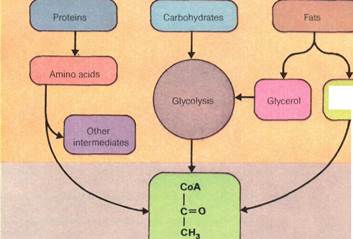
CATEGORIES:
BiologyChemistryConstructionCultureEcologyEconomyElectronicsFinanceGeographyHistoryInformaticsLawMathematicsMechanicsMedicineOtherPedagogyPhilosophyPhysicsPolicyPsychologySociologySportTourism
Krebs cycle or citric acid cycle
The Krebs cycle is named after the Anglo-German biochemist Hans Krebs, who discovered
| Ik Oxygen %Tent ____ |
Oxygen absent
| ) |
| 6 ADP |
| 6 ATP |
Two molecules of carbon dioxide
| ) |
| J |
| Hydrogen carrier system |
Four atoms of hydrogen

|
Two molecules of acetyl coenzyme A (a two-carbon compound)
it in 1937. It is the final stage in aerobic oxidation. It is also the most significant stage in terms of total energy yield. An equivalent of 12 ATP molecules are formed for each acetyl group oxidized via the cycle. Overall, 38 molecules are formed during the complete oxidation of a single glucose molecule. The oxidation is achieved through aerobic glycolysis and the citric acid cycle. Aerobic means "in the presence of oxygen." This compares with only two ATP units formed in anaerobic (without oxygen) glycolysis. In this process, a large amount of the total glucose energy remains locked up in the lactic acid or ethanol produced. The citric acid cycle is a highly complex sequence of reactions catalyzed by a number of enzymes, all found within the mitochondria. It begins with the transfer of the acetyl group to the four-carbon oxaloacetic acid molecule. This produces a six-carbon molecule of citric acid.
The citric acid is rearranged to produce isocitric acid. Then, two carbon atoms are sequentially lost (as carbon dioxide) to form first alpha-oxoglutaric acid and then succinic acid. In both these reactions, hydrogen atoms are transferred to the coenzyme NAD. Three ATP molecules are produced as the hydrogen atoms pass down the mitochondrial respiratory chain, as previously described. In the second reaction, a molecule of guanosine triphosphate (GTP) is made. Like ATP, this is an energy-transferring molecule derived from a purine base, guanine, described in the previous article. The GTP subsequently transfers its end phosphate to ADP, thus making ATP.
The succinic acid molecule (formed when the citric acid lost two carbon atoms) now loses two hydrogen atoms. This forms fumaric acid and another two ATP molecules. Although no more carbon atoms are lost after succinic acid, two further conversions take place. A water molecule is added to form
Biochemistry: Biochemical energy 119
 | |||||
 | |||||
 | |||||

|

|
| Fatty acids |
 L-malic acid. Another pair of hydrogen atoms are lost to produce oxaloacetic acid. This leads to the formation of another three ATP molecules. The newly formed oxaloacetic acid is then ready to start the cycle again.
L-malic acid. Another pair of hydrogen atoms are lost to produce oxaloacetic acid. This leads to the formation of another three ATP molecules. The newly formed oxaloacetic acid is then ready to start the cycle again.
Date: 2015-12-11; view: 3505
| <== previous page | | | next page ==> |
| Hydrogen and electron carriers | | | Fatty acid oxidation |